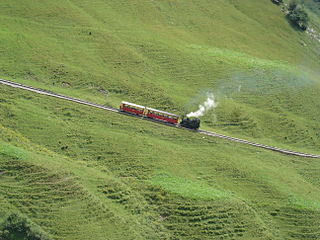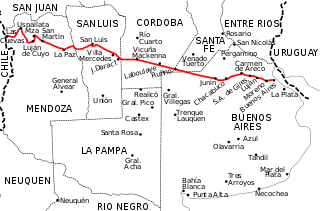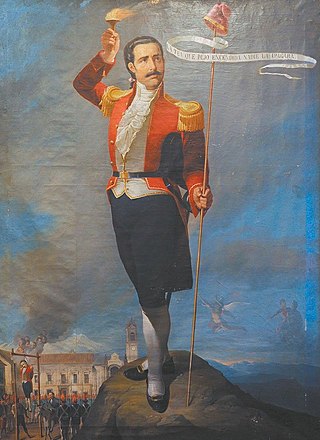
La Paz, officially known as Nuestra Señora de La Paz, is the seat of government of the Plurinational State of Bolivia. With an estimated 816,044 residents as of 2020, La Paz is the third-most populous city in Bolivia. Its metropolitan area, which is formed by La Paz, El Alto, Achocalla, Viacha, and Mecapaca makes up the second most populous urban area in Bolivia, with a population of 2.0 million, after Santa Cruz de la Sierra with a population of 2.3 million. It is also the capital of the La Paz Department.

A mountain railway is a railway that operates in a mountainous region. It may operate through the mountains by following mountain valleys and tunneling beneath mountain passes, or it may climb a mountain to provide transport to and from the summit.
La Paz is the administrative capital of Bolivia.

Mendoza, officially Province of Mendoza, is a province of Argentina, in the western central part of the country in the Cuyo region. It borders San Juan to the north, La Pampa and Neuquén to the south, San Luis to the east, and the republic of Chile to the west; the international limit is marked by the Andes mountain range. Its capital city is the homonymous city of Mendoza.

La Paz is the capital city of the Mexican state of Baja California Sur and an important regional commercial center. The city had a 2020 census population of 250,141 inhabitants, making it the most populous city in the state. Its metropolitan population is somewhat larger because of the surrounding towns, such as El Centenario, Chametla and San Pedro. It is in La Paz Municipality, which is the fourth-largest municipality in Mexico in geographical size and reported a population of 292,241 inhabitants on a land area of 20,275 km2 (7,828 sq mi). The population of La Paz has grown greatly since the 2000s.

San Rafael is one of the departments of Mendoza Province, Argentina. The seat of the department is in the city of San Rafael.

Chacaltaya is a mountain in the Cordillera Real, one of the mountain ranges of the Cordillera Oriental, itself a range of the Bolivian Andes. Its elevation is 5,421 meters (17,785 ft). Chacaltaya's glacier — which was as old as 18,000 years — had an area of 0.22 km2 (0.085 sq mi) in 1940, which had been reduced to 0.01 km2 (0.0039 sq mi) in 2007 and was completely gone by 2009. Half of the meltdown, as measured by volume, took place before 1980. The final meltdown after 1980, due to missing precipitation and the warm phase of El Niño, resulted in the glacier's disappearance in 2009. The glacier was located about 30 kilometers (19 mi) from La Paz, near Huayna Potosí mountain.
Departments form the second level of administrative division, and are subdivided in municipalities. They are extended in all of Argentina except for the Province of Buenos Aires and the Autonomous City of Buenos Aires, the national capital, each of which has different administrative arrangements.
La Paz is a department in the province of Mendoza, Argentina, headquartered in the town of the same name, located 145 km from the provincial capital. It limits to the north with the Lavalle department, to the south with San Rafael, to the west with Santa Rosa and to the east with the province of San Luis.

Ruben Wálter Paz Márquez is a Uruguayan former professional footballer who played as a midfielder. Paz played at two FIFA World Cups for Uruguay and was also South American Footballer of the Year in 1988. He retired in 2006 at the age of 47. He's currently Peñarol's assistant coach.

Cotija is a municipality located in the Mexican state of Michoacán. The municipality has an area of 504.05 km2, and is bordered to the north by Jiquilpan and Villamar, to the east by Tocumbo, and to south by the state of Jalisco. The municipality had a population of 18,207 inhabitants according to the 2005 census. Its municipal seat is the city of Cotija de la Paz.

National Route 7 is a road in Argentina. It crosses the country from east to west, from the capital to the border with Chile, thus linking the Atlantic coast with the Andes, crossing the provinces of Buenos Aires, Santa Fe, Córdoba, San Luis and Mendoza. It has a total length of 1,224 km (761 mi), of which 367 km (228 mi) (30%) are freeways.
Alonso de Mendoza was a Spanish captain, conquistador, and the founder of the city of Nuestra Señora de La Paz. He was appointed by Pedro de la Gasca, the "Peacemaker," to found the city to commemorate the peace in the Peruvian colonies after the defeat of the Pizarro brothers.
Red UNO de Bolivia is a national Bolivian television network. It started operations in April 1984. Its most notable programming is Notivision (news) and "El Mañanero ". It also maintains affiliation deals with three channels in Potosí, Sucre and Tarija.

Carlos Mendoza Davis is a Mexican public official who served as the Governor of Baja California Sur from 2015 to 2021. A lawyer by profession, he has earned two master's degrees and has held several positions in the federal government. From May 2007 to October 2010, he served as the regional representative of the Mexican Social Security Institute (IMSS) in Baja California Sur.

La Paz was founded in 1548 by the Spanish conquistadors at the site of the Native American settlement Laja; the full name of the city was originally Nuestra Señora de La Paz. The name commemorated the restoration of peace following the insurrection of Gonzalo Pizarro and fellow conquistadors four years earlier against Blasco Núñez Vela, the first viceroy of Peru. The city was later moved to its present location in the valley of Chuquiago Marka.

The Plaza Murillo is the central plaza of the city of La Paz and the open space most connected to the political life of Bolivia. Prominent buildings on the plaza include the Presidential Palace, National Congress of Bolivia, and the Cathedral of La Paz. It is located in the old town, or Casco Viejo, of the city and is surrounded by Socabaya Street to the west, Ayacucho Street to the east, Comercio Street to the south, and a continuation of Ingavi and Ballivan Streets to the north.
Anarchism in Bolivia has a relatively short but rich history, spanning over a hundred years, primarily linked to syndicalism, the peasantry, and various social movements. Its heyday was during the 20th century's first decades, between 1910 and 1930, but a number of contemporary movements still exist.
Awkimarka is an archaeological site in the Apurímac Region in Peru. It lies on a mountain of the same name which reaches a height of about 4,000 metres (13,123 ft). It is situated in the Apurímac Region, Andahuaylas Province, on the border of the districts of Pomacocha and Tumay Huaraca.
The following is a chronology of notable events from the year 2023 in Bolivia.












